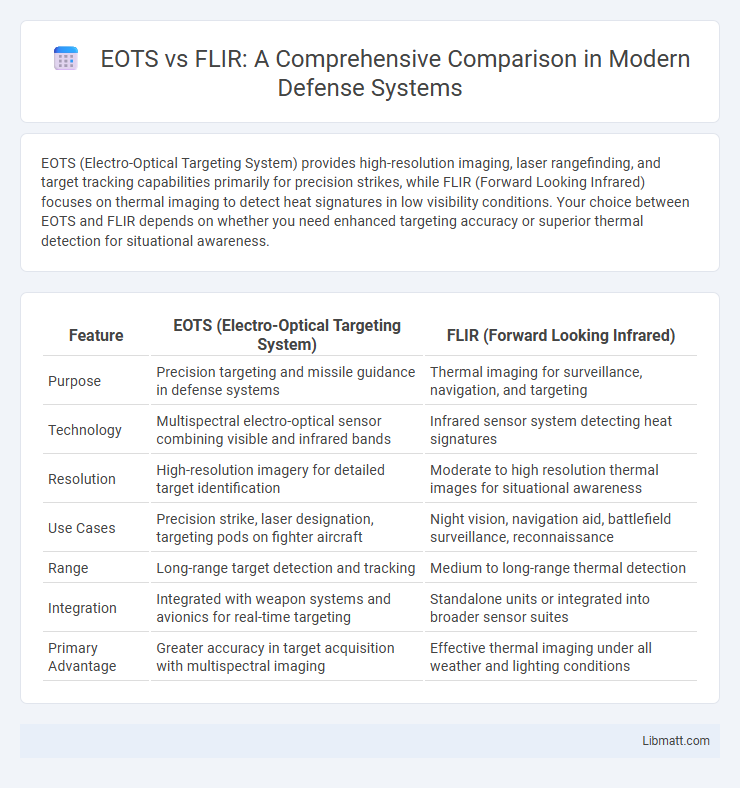EOTS (Electro-Optical Targeting System) provides high-resolution imaging, laser rangefinding, and target tracking capabilities primarily for precision strikes, while FLIR (Forward Looking Infrared) focuses on thermal imaging to detect heat signatures in low visibility conditions. Your choice between EOTS and FLIR depends on whether you need enhanced targeting accuracy or superior thermal detection for situational awareness.
Table of Comparison
| Feature | EOTS (Electro-Optical Targeting System) | FLIR (Forward Looking Infrared) |
|---|---|---|
| Purpose | Precision targeting and missile guidance in defense systems | Thermal imaging for surveillance, navigation, and targeting |
| Technology | Multispectral electro-optical sensor combining visible and infrared bands | Infrared sensor system detecting heat signatures |
| Resolution | High-resolution imagery for detailed target identification | Moderate to high resolution thermal images for situational awareness |
| Use Cases | Precision strike, laser designation, targeting pods on fighter aircraft | Night vision, navigation aid, battlefield surveillance, reconnaissance |
| Range | Long-range target detection and tracking | Medium to long-range thermal detection |
| Integration | Integrated with weapon systems and avionics for real-time targeting | Standalone units or integrated into broader sensor suites |
| Primary Advantage | Greater accuracy in target acquisition with multispectral imaging | Effective thermal imaging under all weather and lighting conditions |
Introduction to EOTS and FLIR Systems
EOTS (Electro-Optical Targeting System) and FLIR (Forward-Looking Infrared) systems are advanced technologies used for surveillance, targeting, and reconnaissance in military and security applications. EOTS integrates multiple sensors such as infrared, laser rangefinders, and visible cameras to provide precise targeting and tracking capabilities. Your choice between EOTS and FLIR depends on mission requirements, as FLIR mainly relies on thermal imaging for detecting heat signatures, while EOTS offers a broader sensor suite for enhanced situational awareness.
Core Functions: What is EOTS?
EOTS (Electro-Optical Targeting System) integrates advanced infrared sensors and laser rangefinders to deliver precise target detection, identification, and tracking capabilities primarily for military aircraft. Its core functions include real-time imaging, target designation, and laser-guided weapon targeting, enabling enhanced situational awareness and mission accuracy. Your ability to engage targets effectively is significantly improved by EOTS due to its superior sensor fusion and targeting precision compared to traditional FLIR systems.
Core Functions: What is FLIR?
FLIR, or Forward-Looking Infrared, is a technology that captures thermal images by detecting infrared radiation emitted by objects. It enables visibility in low-light, night, or obscured conditions by providing real-time temperature-based imagery, essential for surveillance, targeting, and navigation. FLIR systems are widely used in military, aviation, and security applications to enhance situational awareness through thermal detection.
Key Technological Differences: EOTS vs FLIR
EOTS (Electro-Optical Targeting System) integrates high-resolution visible and infrared sensors for precise targeting and tracking, while FLIR (Forward-Looking Infrared) primarily uses thermal imaging to detect heat signatures in various conditions. EOTS offers advanced laser rangefinding and target identification capabilities, enhancing situational awareness and engagement accuracy. Your choice between EOTS and FLIR depends on the specific operational need for either multi-spectral targeting or heat-based detection.
Performance Comparison in Modern Aircraft
EOTS (Electro-Optical Targeting System) delivers superior multi-spectral imaging and laser designation capabilities compared to FLIR (Forward Looking Infrared), enhancing target acquisition and identification accuracy in modern aircraft. EOTS integrates seamlessly with advanced avionics, providing pilots with high-resolution targeting data under diverse environmental conditions. Your mission effectiveness improves significantly with EOTS' ability to detect and track threats at greater distances and with enhanced precision.
Applications in Military Aviation
EOTS (Electro-Optical Targeting System) and FLIR (Forward-Looking Infrared) are critical technologies in military aviation for enhanced targeting, reconnaissance, and surveillance operations. EOTS integrates laser targeting, infrared, and daylight sensors to provide precision targeting and missile guidance in aircraft like the F-35, whereas FLIR primarily offers thermal imaging to detect heat signatures in low visibility conditions for navigation and threat detection. Both systems improve situational awareness and targeting accuracy, with EOTS being more advanced in multi-sensor integration and laser designation capabilities.
Advantages and Limitations of EOTS
EOTS (Electro-Optical Targeting System) offers high-resolution imaging, precise targeting capabilities, and enhanced situational awareness in various military platforms, outperforming FLIR (Forward Looking Infrared) in multi-spectral detection and daylight performance. Limitations of EOTS include susceptibility to adverse weather and limited night-time effectiveness compared to thermal imaging systems like FLIR, which excel in low-visibility conditions. The integration of EOTS provides improved target identification accuracy but requires complementary sensors for all-weather, 24/7 operational readiness.
Advantages and Limitations of FLIR
Forward-Looking Infrared (FLIR) systems offer significant advantages in detecting thermal signatures through smoke, fog, and darkness, providing essential capabilities for night vision and surveillance. Their passive detection method reduces vulnerability to countermeasures compared to active sensors, enhancing stealth operations. However, FLIR performance can be limited by environmental factors like heavy rain or extreme atmospheric conditions that degrade infrared transmission and image clarity.
Integration with Next-Generation Fighter Jets
EOTS (Electro-Optical Targeting System) offers advanced integration capabilities with next-generation fighter jets by providing seamless compatibility with aircraft avionics, enabling real-time targeting and tracking data fusion. FLIR (Forward-Looking Infrared) systems, while effective for thermal imaging, often require additional processing units to integrate fully with modern jet platforms, which can limit the speed of data transmission and response. Your aircraft's combat effectiveness improves significantly when utilizing EOTS due to its streamlined integration and enhanced situational awareness features tailored for advanced fighter jet architecture.
Future Developments and Industry Trends
EOTS (Electro-Optical Targeting Systems) and FLIR (Forward-Looking Infrared) technologies are rapidly advancing with enhanced sensor fusion, increased resolution, and AI-driven target recognition capabilities. Industry trends emphasize miniaturization and integration with unmanned systems, improving situational awareness and operational efficiency in defense applications. Future developments aim to incorporate multi-spectral imaging and automated threat analysis to provide comprehensive, real-time battlefield intelligence.
EOTS vs FLIR Infographic

 libmatt.com
libmatt.com